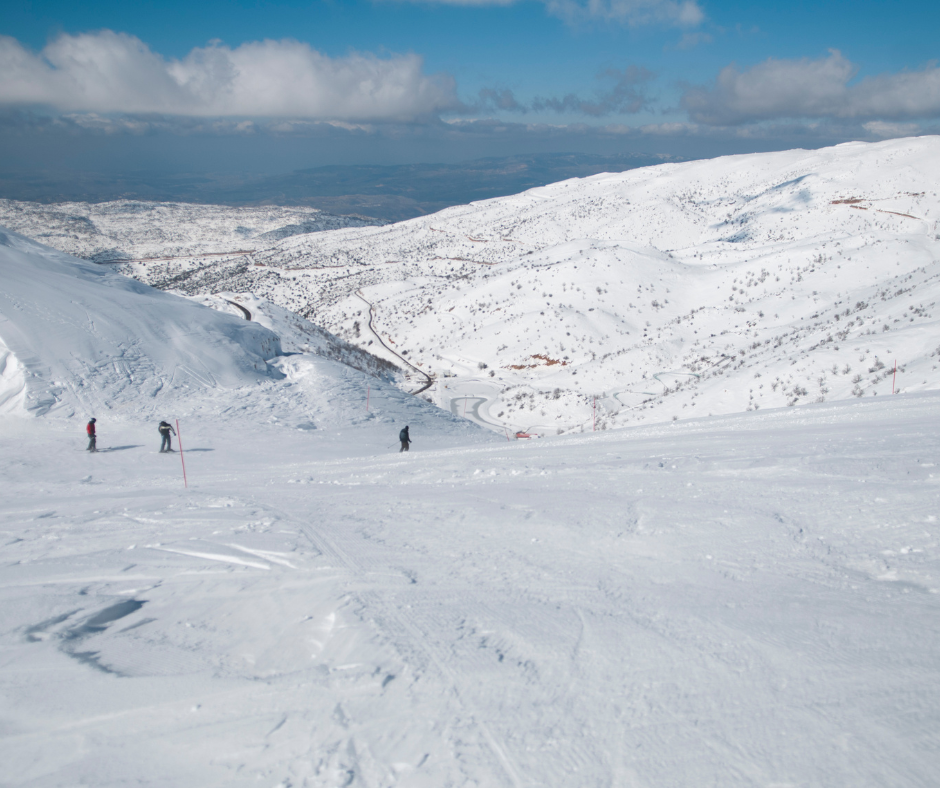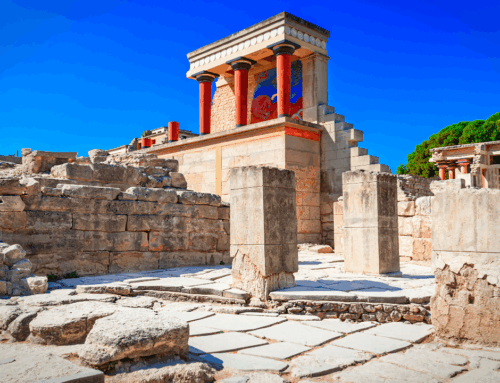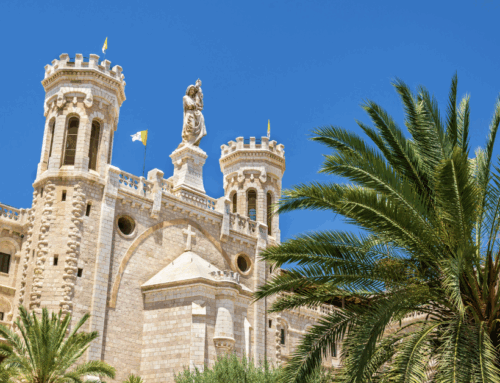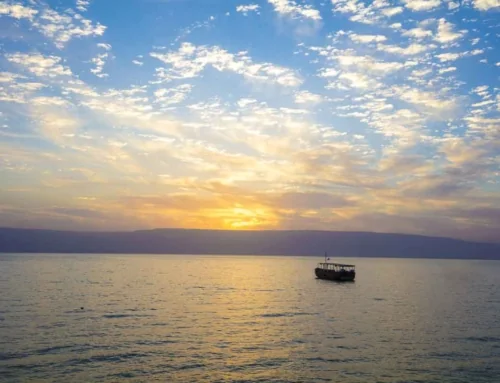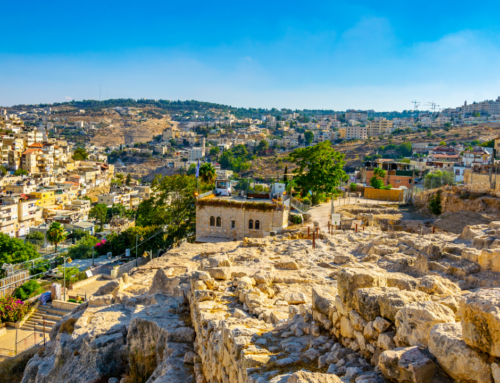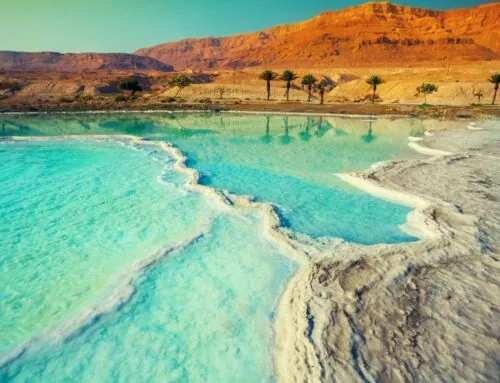Amazing Mountains in Israel
The small yet incredibly diverse landscape and environment of the country of Israel uncovers the marvel of the mountains in Israel. This diverse land includes the beaches of the Mediterranean and Red Sea, the deserts of Judea and Negev, and the mountains and valleys.
The beauty of the mountains in Israel hold significant meanings throughout the Bible and history.
Connections between the Mountains in Israel and Biblical Accounts
Historical Locations and Monuments on the Mountains in Israel
Israel’s mountainous terrain is adorned with historical locations and monuments that serve as the backdrop for the tales of antiquity. Mount Carmel, overlooking the Mediterranean, is home to ancient caves and archaeological sites, bearing witness to the region’s rich past. The Judean Mountains cradle Jerusalem, showcasing iconic landmarks like the historic Mount of Olives. The rugged landscapes of the Galilee region holds sites like Mount Tabor, associated with biblical events. As you ascend these peaks, you encounter the remains of ancient fortifications, religious structures, and monuments, each revealing a layer of Israel’s diverse history.
These mountainous realms serve as living testimonies to the civilizations, cultures, and events that have shaped this land across millennia, inviting visitors to explore and connect with the intricate tapestry of Israel’s past.
The Judean Mountains
Judean mountains, one of the breathtaking mountains in Israel, reach a grand height of nearly 4,000 feet. For thousands of years, the Judean Mountains have been linked to winemaking. This is evident in the numerous ancient winepresses discovered, mentions of wine in texts like the Hebrew Bible, and archaeological discoveries like the Arad ostraca, inscribed by Judahite soldiers in the late 7th century BCE.
“I lift up my eyes to the mountains — where does my help come from? My help comes from the LORD, the Maker of heaven and earth.”- Psalm 121
When David spoke of these mountains he was in hiding from King Saul and was most likely referring to the mountains of Israel known as the Judean Mountains. These hills encompass a north-south ridge that includes the cities of Jerusalem, Bethlehem and Hebron.
The site of Ein Karem is also located in the Judean Mountains. Here, Mary visited her cousin Elizabeth and Elizabeth’s husband Zechariah, the parents of John the Baptist.
Mount Tabor
Standing tall eleven miles west to the Sea of Galilee is the historic Mount Tabor in Israel. The Bible frequently depicts the mountains of Israel as symbolic representations of life’s peaks and valleys. Mount Tabor, in particular, is considered a pinnacle of humanity, as some believe it is the location where Christ underwent transfiguration, revealing his divine glory.
Although there is ongoing debate about the accuracy of this belief, the Basilica of the Transfiguration stands on the mountain. Owned by the Franciscans and built in 1924, it is part of a historical lineage of churches in this location, with the first documented mention dating back to 570 AD, though its origins could extend even earlier.
Mount of Olives
Reaching its highest point at nearly 2700 ft, the Mount of Olives in Israel is a noteworthy watershed for Jerusalem.
It is named for the olive groves that once covered its slopes. The southern part of the mount was the Silwan necropolis, attributed to the elite of the ancient Kingdom of Judah. The western slopes of the mount, those facing Jerusalem, have been used as a Jewish cemetery for over 3,000 years and holds approximately 150,000 graves, making it central in the tradition of Jewish cemeteries.
The Mount of Olives holds significance in the life of Jesus, with several key events from the Gospels unfolding there. According to the Acts of the Apostles, it is described as the location from which Jesus ascended to heaven. Due to its association with both Jesus and Mary, the mount has been a place of Christian worship since ancient times and remains a major pilgrimage site today.
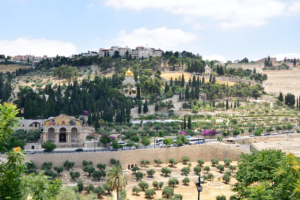
Gethsemane garden on Mount of Olives slope in Jerusalem
Mount Moriah
The hills of Jerusalem are covered in biblical history, and among them, Mt. Moriah features one of the oldest tales in the Bible (Genesis 22:1-19). It recounts the story of Abraham and his son Isaac, wherein God instructed Abraham to offer Isaac as a sacrifice on the mountain. In a crucial moment, God intervened, preventing the sacrifice and offering an alternative.
Mount Moriah is traditionally identified as the location where King Solomon built the First Temple in Jerusalem. The Temple was a central place of worship for the Israelites and housed the Ark of the Covenant. The temple was later destroyed by the Babylonians in 586 BCE, leading to the Babylonian exile of the Israelites. After the Babylonian exile, the Second Temple was constructed on Mount Moriah, eventually becoming the center of Jewish worship. This temple was later expanded and renovated by King Herod.
Mount of Beatitudes
While most of the mountains of Israel we are discussing are proper mountains (over 1000 feet above surrounding areas), this “mount” is actually a hill. Its’ highest point reaching a little over 650 feet and actually, it is 82 feet below sea level! This makes it one of the lowest summits in the world!
Also known as Mount Eremos, this hill is where Jesus gave his famous sermon: the Sermon on the Mount. On the hillside you can identify a natural amphitheater with fantastic acoustics. This allowed a crowd to hear a speaker clearly, with a beautiful view of the Sea of Galilee.
Today, you can follow in the footsteps of Jesus and thousands of years of followers and visit the site. During the 4th century, during the Byzantine era, a church was constructed and in used until the 7th century. In the 1930s, the Roman Catholic Franciscan chapel was built, but the original cistern and monastery can still be seen.
Mt. Carmel
Mt. Carmel in Israel, renowned for its long history, beautiful panoramas and biblical significance as the showdown location between Elijah and the prophets of Baal, is truly captivating. According to the Bible in the First Book of Kings (1 Kings 18), Elijah confronted the prophets of Baal on Mount Carmel. Elijah’s challenge, the contest of the gods, took place at a location traditionally associated with Mount Carmel. The Bible recounts how Elijah built an altar on Mount Carmel and called upon the God of Israel to send fire to consume the offering. Then, fire descended from heaven, validating the God of Israel as the true deity.
At 1791 ft high it offers sweeping views of the valleys and, inspired by the biblical connection to Mount Carmel, the Carmelite Order was founded. The order traces its roots to hermits who lived on Mount Carmel during the Crusader period. Mount Carmel, with its historical and biblical associations, has become a symbol of spiritual contemplation and devotion. It serves as a metaphorical mountaintop experience, representing the pursuit of a closer relationship with God.
Mt. Hermon
Among the mountains in Israel, Mount Hermon stands out for its exceptional diversity. Located in the northern part of Israel, this mountain extends into Syria and Lebanon. With an elevation exceeding 9000 feet, its highest point within Israel reaches 7,336 feet above sea level.
Mount Hermon holds significance in the Bible for several reasons. It served as a geographical marker, indicating the northern limits of the Promised Land conquered by Joshua, as mentioned in Deuteronomy 3:8, Joshua 11:17, 12:1, and 13:5. Additionally, Mount Hermon formed the northern boundary of the territory inherited by the half-tribe of Manasseh and served as the northern border of Israel overall, as stated in 1 Chronicles 5:23.
Today, Mt. Hermon is located in what is known as the Golan Heights.
Popular Outdoor Activities on the Mountains in Israel
The Israeli portion of the Hermon mountain actually has a ski resort! In the summer months, Israelis seek relief from the heat by heading to the mountains, where they can enjoy cooler temperatures and engage in activities like hiking and thrilling outdoor pursuits, including an alpine roller coaster!
We hope you enjoy the mountains of Israel the next time you join us! Contact Immanuel Tours today to get your free, no-commitment and no-risk tour proposal for your journey in 2024 and beyond!

